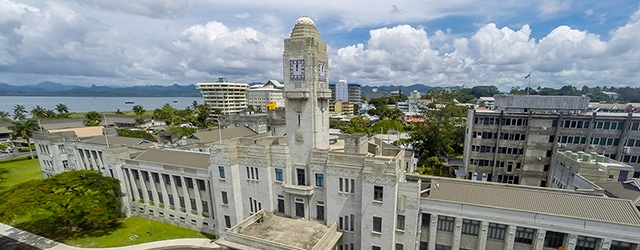The small Pacific island nation will host the annual lenders' meeting to discuss sustainable economic development and disaster resilience.

Fiji will be the first Pacific Small Island Developing State member to host the multilateral lenders’ annual meeting, which expects to draw more than 3,000 participants. The meeting is an opportunity for Asian Development Bank (ADB) governors, government officials, private businesses, nonprofits, development partners and other experts to discuss the region’s critical issues and challenges.
Anchored by the theme Prosperity Through Unity, the meeting will focus on the development of sustainable tourism and the management of ocean health, issues that are important not only for Fiji and other Pacific countries but also for the rest of Asia. Seven out of 10 countries with the highest estimated disaster risk in the world are ADB developing member countries: Bangladesh, Cambodia, the Philippines, Solomon Islands, Timor-Leste, Tonga and Vanuatu.
Across the Pacific region, ADB is significantly scaling up financing to help developing-country members achieve sustainable economic and social development, while strengthening climate and disaster resilience.
The bank, which has committed 593 million Fijian dollars ($278 million) in assistance to Fiji since it joined the bank in 1970, expects to invest about 280 million Fijian dollars ($131 million) in the country in 2019 to 2020.
“The ADB will continue to support Fiji’s efforts to achieve sustained, inclusive, private sector–led growth that brings benefits to the entire population,” said ADB President Takehiko Nakao during a visit to the island nation in January. Nakao, a strong advocate of public-private partnerships since he assumed the bank presidency in 2013, visited Sun Pacific Energy’s solar farm, a $2 million project financed by the bank’s private-sector operations department.
An increased focus on the private sector is one of the critical adjustments made by the Manila-based multilateral lender in recent years. Recognizing the huge increase in the cost and number of development projects needed across the region, the bank has pledged to boost its funding for private-sector projects to one-third of its total project pipeline by 2024, up from one-fifth in 2017.
“We will expand our private-sector operations in new and frontier markets, such as fragile and conflict-affected situations and small-island developing states, and support more public-private partnerships,” Nakao said. “A key measure of our success will be the volume and quality of additional resources we mobilize on top of our own financing.”
ADB is developing alternative financing structures and backing green finance to encourage a bankable green-finance project pipeline that can access funds from commercial and institutional investors. Many major investors are now subject to strict environmental, social and governance requirements in their investment decisions.
“We need many more, better-prepared projects that are considered bankable and investible by the private sector,” said Michael Barrow, director general of the ADB’s private sector operations department in an interview with FinanceAsia. Barrow thinks more sources of financing are needed, including institutional investors such as insurance companies and pension funds, through funding platforms, project bonds and risk transfers.
While Asia and the Pacific has been the world’s fastest-growing region in recent decades and poverty has been greatly reduced, its development agenda isn’t complete.
One in three people in the region still lives on less than $3.20 a day. That is 1.24 billion people. About $1.7 trillion a year is needed between 2016 and 2030 to fill the region’s infrastructure gaps. And there is a wide range of other issues troubling the Asia-Pacific region, from climate change to natural disasters to an aging population in countries such as China and Japan.
Under ADB’s Strategy 2030, the bank will expand its vision to achieve a prosperous, inclusive, resilient, and sustainable economy in Asia and the Pacific, while sustaining its efforts to eradicate extreme poverty.
Established in 1966, ADB is owned by 67 members, including 48 from the region. Its main instruments for helping its developing member countries are policy dialogue, loans, equity investments, guarantees, grants and technical assistance. In 2017, ADB operations totaled $32.2 billion, including $11.9 billion in co-financing.



